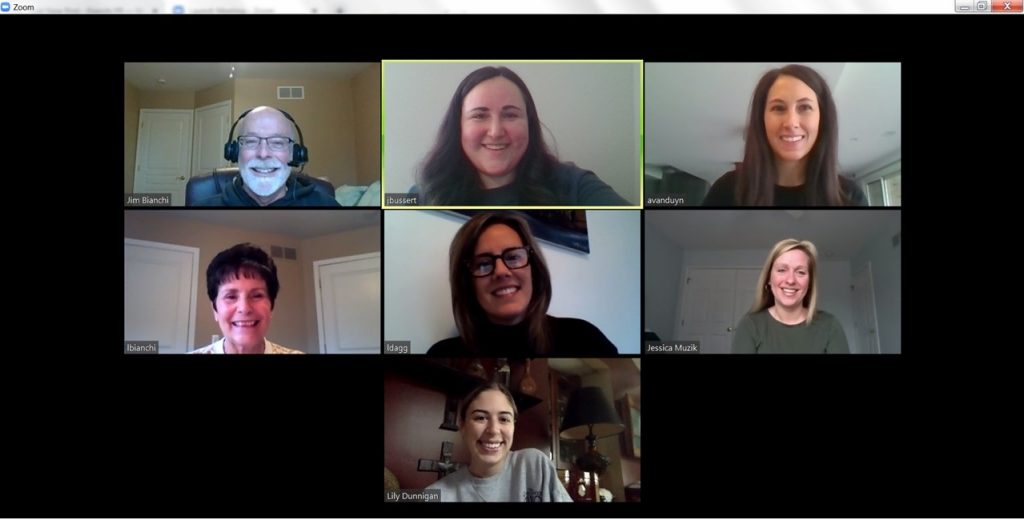880 W. Long Lake Road • Suite 225 •
Troy, Michigan 48098
• P: 248.269.1122 •
E: bianchipr@bianchipr.com

With COVID-19 “stay at home, stay safe, save lives” orders now firmly in place nearly everywhere, those that are working from home are finding themselves using one of a variety of video meeting services such as Skype, Zoom, WebEx, Abobe Connect, Microsoft Teams and others to stay connected and accomplish day-to-day business activities.
Here are some helpful tips that we have found for achieving the best possible video conference meetings with your colleagues and customers:
Be sure you have a good connection – A stable, fast and reliable Internet connection is key to any successful video conference meeting. If you’ve found that your home Internet is prone to “go out,” you will want to make sure that you are sitting near your router or, better yet, use a hard wire connection. You might also consider upgrading your home service to “business class” internet service, which obviously is more costly, but may be well worth it if you’re having internet speed or bandwidth problems that can arise when multiple people are home putting unusual demand on your internet;
Select a video conference service that works best for everyone – Whether it’s Skype, Zoom or one of the many other video conference meeting services available, make sure that you have selected a service that works well for everyone. Also, you will want to make sure that you test the service before utilizing it for a actual meeting, so that you can ensure that the video and audio are working properly when you join the video conference meeting;
Familiarize yourself with the features – Take some time upfront to become acquainted with the features of the video conference service you have chosen to utilize. If you are the host, make a point to inform the other participants how to utilize the features to help ensure that the participants are able to utilize the necessary video conference features. Two must-know features are muting and unmuting the microphone and sharing screens;
Location, location, location … and lighting – Pick a suitable location within your home that is free from distraction, quiet, professional and void of any background noise. Speaking of backgrounds, make sure the visual background is uncluttered and tidy, so that visually it does not distract people from your comments. If you are using a virtual background, such as a photo of board room that you’ve loaded into the application, make sure to use a green background, so your face doesn’t fade in and out. Also, if you’re using a laptop or notebook computer for the video conference, remember to put your cell phone on mute. Good lighting is also key. Chose a location within your home that has proper lighting, as well as minimal glare. If possible, make sure that there is good natural but diffused light on your face and avoid sitting between your camera and the window where your image could be backlit. If possible, sit at a desk or table with your face and computer screen facing the window light and your back against a wall that is not too distracting for your audience;
Level up your camera – Position your device’s camera so that it is straight on or even pointed slightly downward toward your eyes. If the camera is lower than your eyes, those that you are meeting with will get a very unflattering viewing angle of your face. Use books or a shelf – something stable – to get the camera to the right height. And make sure you frame yourself in the center of the screen;
Enhance the sound – Consider using a headset with a microphone to enhance the sound quality of your video meetings. This will improve the quality of the meeting for both you and the other participants. And make sure to enunciate clearly and inject enthusiasm, passion and energy into your voice, to make up for some of the visual cues that will be missing because of the virtual nature of the meeting. On a video conference, you have to work a little harder to get your point across;
Dress professionally – As with in-person meetings, you’ll want to dress properly and professionally, just as if the meeting were taking place face-to-face in your client’s office or conference room. Also, be sure to develop a meeting agenda and share it with your video conference participants, so that everyone can be on the same page. This will help the meeting to go as smoothly and productively as possible;
Consider the time zones – Given the globalization of nearly all industries these days, it is important to be mindful of time zones when setting meetings. So, before you send a video conference meeting invite, make sure that the day and time is convenient for all involved and that the invite offers clearly marked time zone information;
Maintain eye contact – Try to keep good eye contact with your audience, in this case, your camera lens. Wandering eyes can be distracting and uncomfortable. Look into the lens and maintain that contact. Try to avoid fidgeting with your hands, glasses or pens. Also, watch that your body language doesn’t send signals that conflict with your words. Sit up straight or stand, keep your shoulders relaxed, gesture as you normally would and smile; and
Hold that thought – In spite of the many improvements in video technology, you may still experience a delay in the conversations. If you are experiencing this lag, try to maintain eye contact and be patient – pause for a few seconds after someone has spoken before you respond. Otherwise, you risk the frustration of talking over one another in a sort of awkward ping-pong game of fragmented sentences. While it is typically up to the host to manage the video conference meeting, try your best to pause before you speak, so you set a good example for the other participants.
We welcome your feedback … what have we missed from this list of video conference meeting tips and tricks that you have found to be helpful and / or necessary in this new work from home landscape?

Author: Jessica Muzik
Jessica is vice president – account service at Bianchi PR with 24 years of PR experience across the corporate, industrial and community perspectives.